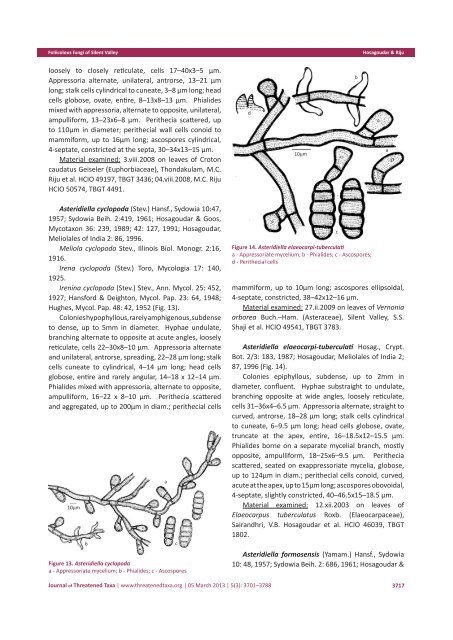PDF - Journal of Threatened Taxa
PDF - Journal of Threatened Taxa
PDF - Journal of Threatened Taxa
Create successful ePaper yourself
Turn your PDF publications into a flip-book with our unique Google optimized e-Paper software.
Foliicolous fungi <strong>of</strong> Silent ValleyHosagoudar & Rijuloosely to closely reticulate, cells 17–40x3–5 µm.Appressoria alternate, unilateral, antrorse, 13–21 µmlong; stalk cells cylindrical to cuneate, 3–8 µm long; headcells globose, ovate, entire, 8–13x8–13 µm. Phialidesmixed with appressoria, alternate to opposite, unilateral,ampulliform, 13–23x6–8 µm. Perithecia scattered, upto 110µm in diameter; perithecial wall cells conoid tomammiform, up to 16µm long; ascospores cylindrical,4-septate, constricted at the septa, 30–34x13–15 µm.Material examined: 3.viii.2008 on leaves <strong>of</strong> Crotoncaudatus Geiseler (Euphorbiaceae), Thondakulam, M.C.Riju et al. HCIO 49197, TBGT 3436; 04.viii.2008, M.C. RijuHCIO 50574, TBGT 4491.d10µmbaAsteridiella cyclopoda (Stev.) Hansf., Sydowia 10:47,1957; Sydowia Beih. 2:419, 1961; Hosagoudar & Goos,Mycotaxon 36: 239, 1989; 42: 127, 1991; Hosagoudar,Meliolales <strong>of</strong> India 2: 86, 1996.Meliola cyclopoda Stev., Illinois Biol. Monogr. 2:16,1916.Irena cyclopoda (Stev.) Toro, Mycologia 17: 140,1925.Irenina cyclopoda (Stev.) Stev., Ann. Mycol. 25: 452,1927; Hansford & Deighton, Mycol. Pap. 23: 64, 1948;Hughes, Mycol. Pap. 48: 42, 1952 (Fig. 13).Colonies hypophyllous, rarely amphigenous, subdenseto dense, up to 5mm in diameter. Hyphae undulate,branching alternate to opposite at acute angles, looselyreticulate, cells 22–30x8–10 µm. Appressoria alternateand unilateral, antrorse, spreading, 22–28 µm long; stalkcells cuneate to cylindrical, 4–14 µm long; head cellsglobose, entire and rarely angular, 14–18 x 12–14 µm.Phialides mixed with appressoria, alternate to opposite,ampulliform, 16–22 x 8–10 µm. Perithecia scatteredand aggregated, up to 200µm in diam.; perithecial cells10µmbFigure 13. Asteridiella cyclopodaa - Appressoriate mycelium; b - Phialides; c - AscosporesacFigure 14. Asteridiella elaeocarpi-tuberculatia - Appressoriate mycelium; b - Phialides; c - Ascospores;d - Perithecial cellsmammiform, up to 10µm long; ascospores ellipsoidal,4-septate, constricted, 38–42x12–16 µm.Material examined: 27.ii.2009 on leaves <strong>of</strong> Vernoniaarborea Buch.–Ham. (Asteraceae), Silent Valley, S.S.Shaji et al. HCIO 49541, TBGT 3783.Asteridiella elaeocarpi-tuberculati Hosag., Crypt.Bot. 2/3: 183, 1987; Hosagoudar, Meliolales <strong>of</strong> India 2;87, 1996 (Fig. 14).Colonies epiphyllous, subdense, up to 2mm indiameter, confluent. Hyphae substraight to undulate,branching opposite at wide angles, loosely reticulate,cells 31–36x4–6.5 µm. Appressoria alternate, straight tocurved, antrorse, 18–28 µm long; stalk cells cylindricalto cuneate, 6–9.5 µm long; head cells globose, ovate,truncate at the apex, entire, 16–18.5x12–15.5 µm.Phialides borne on a separate mycelial branch, mostlyopposite, ampulliform, 18–25x6–9.5 µm. Peritheciascattered, seated on exappressoriate mycelia, globose,up to 124µm in diam.; perithecial cells conoid, curved,acute at the apex, up to 15µm long; ascospores obovoidal,4-septate, slightly constricted, 40–46.5x15–18.5 µm.Material examined: 12.xii.2003 on leaves <strong>of</strong>Elaeocarpus tuberculatus Roxb. (Elaeocarpaceae),Sairandhri, V.B. Hosagoudar et al. HCIO 46039, TBGT1802.Asteridiella formosensis (Yamam.) Hansf., Sydowia10: 48, 1957; Sydowia Beih. 2: 686, 1961; Hosagoudar &c<strong>Journal</strong> <strong>of</strong> <strong>Threatened</strong> <strong>Taxa</strong> | www.threatenedtaxa.org | 05 March 2013 | 5(3): 3701–37883717

















